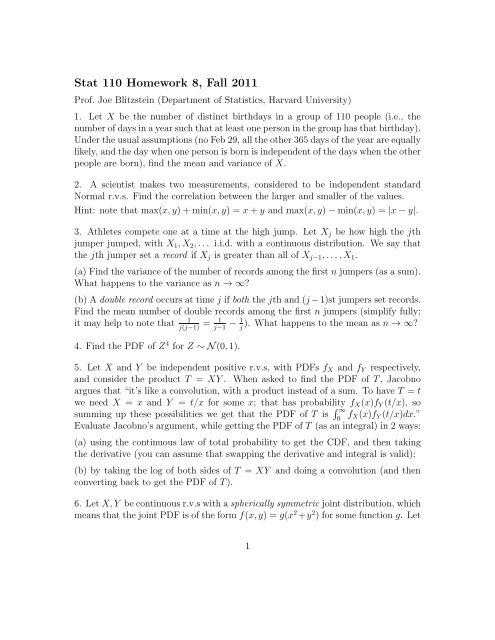Strategic Practice and Homework 8 - Projects at Harvard
Strategic Practice and Homework 8 - Projects at Harvard
Strategic Practice and Homework 8 - Projects at Harvard
You also want an ePaper? Increase the reach of your titles
YUMPU automatically turns print PDFs into web optimized ePapers that Google loves.
St<strong>at</strong> 110 <strong>Homework</strong> 8, Fall 2011Prof. Joe Blitzstein (Department of St<strong>at</strong>istics, <strong>Harvard</strong> University)1. Let X be the number of distinct birthdays in a group of 110 people (i.e., thenumber of days in a year such th<strong>at</strong> <strong>at</strong> least one person in the group has th<strong>at</strong> birthday).Under the usual assumptions (no Feb 29, all the other 365 days of the year are equallylikely, <strong>and</strong> the day when one person is born is independent of the days when the otherpeople are born), find the mean <strong>and</strong> variance of X.2. A scientist makes two measurements, considered to be independent st<strong>and</strong>ardNormal r.v.s. Find the correl<strong>at</strong>ion between the larger <strong>and</strong> smaller of the values.Hint: note th<strong>at</strong> max(x, y)+min(x, y) =x + y <strong>and</strong> max(x, y) min(x, y) =|x y|.3. Athletes compete one <strong>at</strong> a time <strong>at</strong> the high jump. Let X j be how high the jthjumper jumped, with X 1 ,X 2 ,... i.i.d. with a continuous distribution. We say th<strong>at</strong>the jth jumper set a record if X j is gre<strong>at</strong>er than all of X j 1 ,...,X 1 .(a) Find the variance of the number of records among the first n jumpers (as a sum).Wh<strong>at</strong> happens to the variance as n !1?(b) A double record occurs <strong>at</strong> time j if both the jth <strong>and</strong> (j 1)st jumpers set records.Find the mean number of double records among the first n jumpers (simplify fully;1it may help to note th<strong>at</strong> = 1 1). Wh<strong>at</strong> happens to the mean as n !1?j(j 1) j 1 j4. Find the PDF of Z 4 for Z ⇠N(0, 1).5. Let X <strong>and</strong> Y be independent positive r.v.s, with PDFs f X <strong>and</strong> f Y respectively,<strong>and</strong> consider the product T = XY . When asked to find the PDF of T , Jacobnoargues th<strong>at</strong> “it’s like a convolution, with a product instead of a sum. To have T = twe need X = x <strong>and</strong> Y = t/x for some x; th<strong>at</strong>hasprobabilityf X (x)f Y (t/x), sosumming up these possibilities we get th<strong>at</strong> the PDF of T is R 1f0 X (x)f Y (t/x)dx.”Evalu<strong>at</strong>e Jacobno’s argument, while getting the PDF of T (as an integral) in 2 ways:(a) using the continuous law of total probability to get the CDF, <strong>and</strong> then takingthe deriv<strong>at</strong>ive (you can assume th<strong>at</strong> swapping the deriv<strong>at</strong>ive <strong>and</strong> integral is valid);(b) by taking the log of both sides of T = XY <strong>and</strong> doing a convolution (<strong>and</strong> thenconverting back to get the PDF of T ).6. Let X, Y be continuous r.v.s with a spherically symmetric joint distribution, whichmeans th<strong>at</strong> the joint PDF is of the form f(x, y) =g(x 2 +y 2 )forsomefunctiong. Let1
















